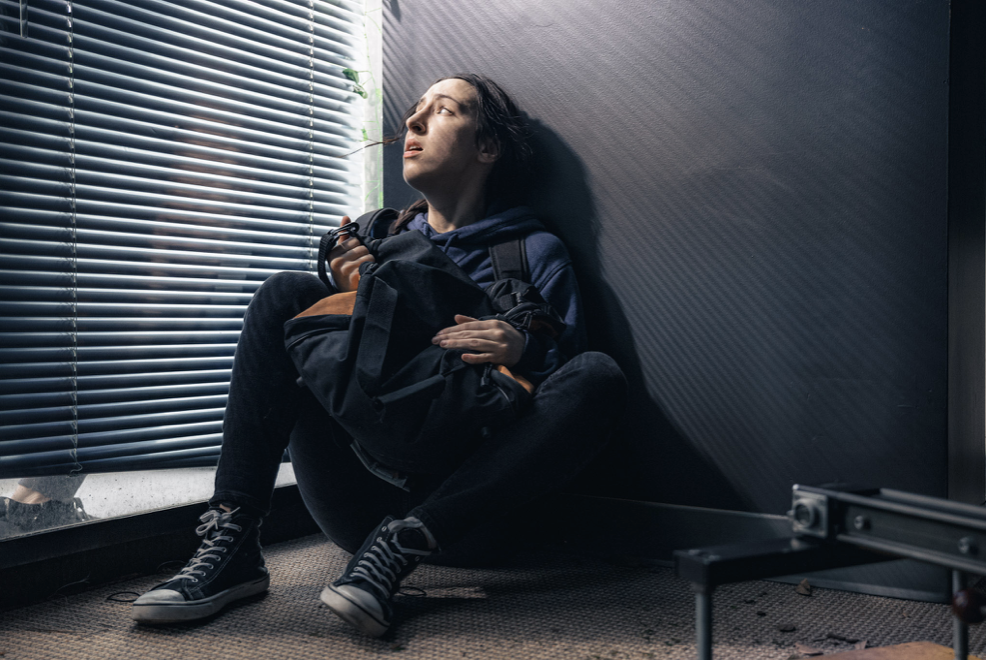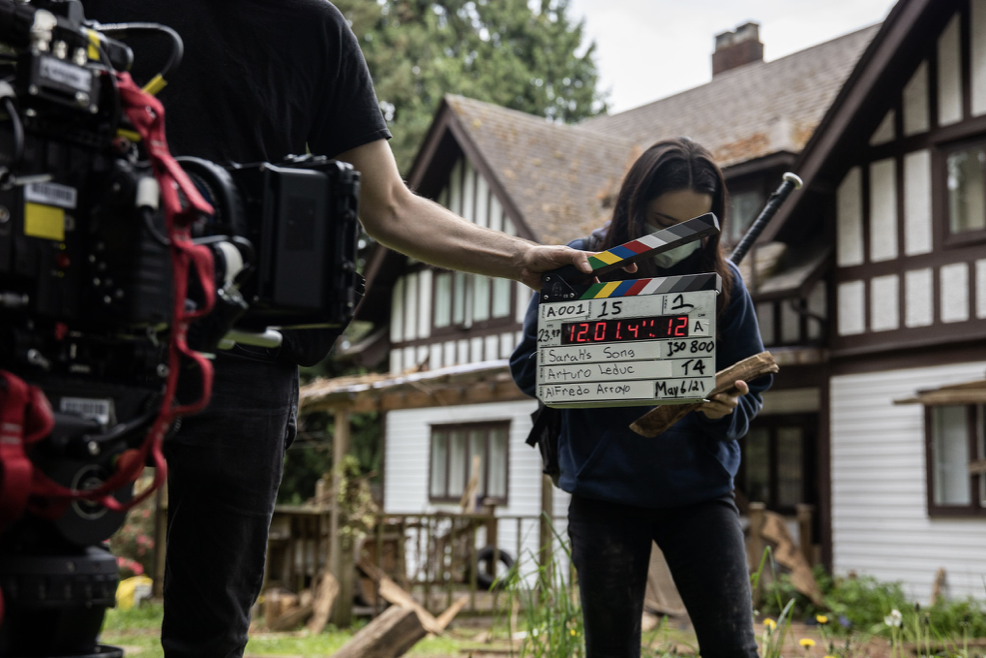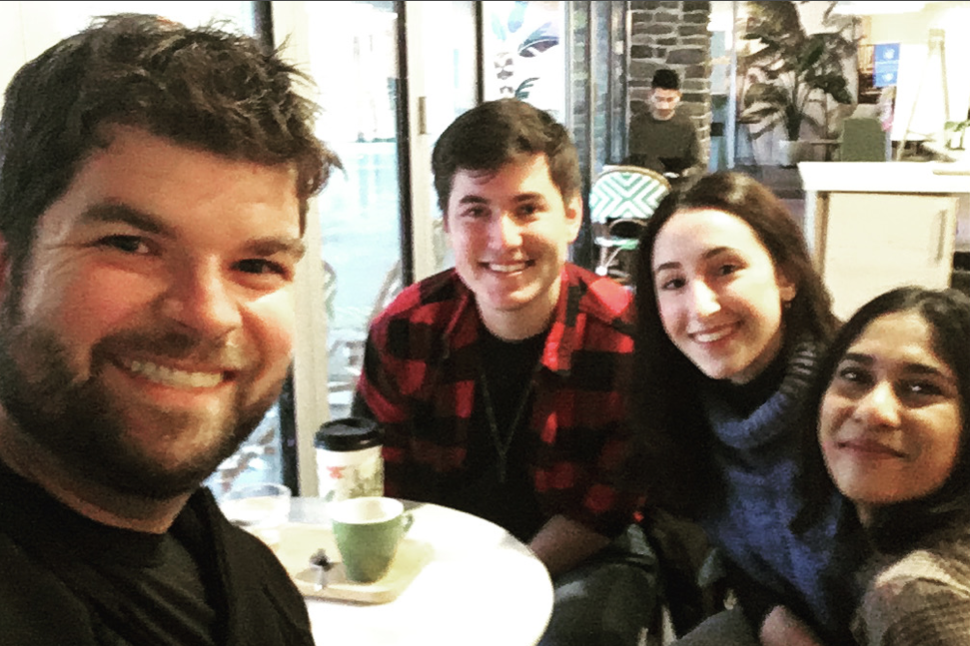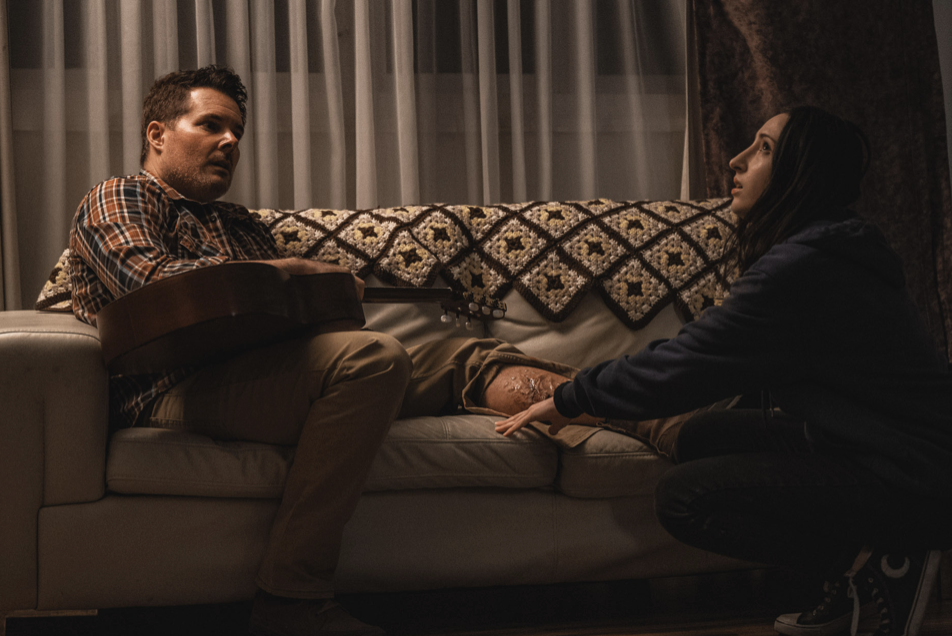As an alumnus of Vancouver Film School (Class FP152), I can attest that a one-year intensive film production program can test the mettle of even the most dedicated aspiring filmmaker. Everyone goes in wanting to be a director, but few graduate with that desire intact. Arturo LeDuc (Class FP196) is one of those few and graduated with a film to show for it.
His post-apocalyptic sci-fi short, Sarah’s Song is a genre piece on the surface, but at its core deals with the pain of personal loss and the necessity of moving forward. Producing any film work is difficult under the best of circumstances, but recent filmmaking has had the extra layer of burdensome COVID protocols to deal with.
No one undertakes a film alone however and Arturo was joined by leading lady Sabrina Valana (Sarah) and producer Reanisa Mendonca as we all gathered at Honolulu Coffee downtown for my first in person interview in nearly two years!
What was the genesis of this film?
Arturo: Originally, I just wrote different plots that I wanted to do for the new project and then it started developing more and more. I’ve mentioned it to some people, but a few months before we made the short film, an uncle of mine passed away and it’s the first time I had dealt with loss.
A lot of that bled into the story and a lot of grief and having to move on in life. I combined that with the original plot that I had and then it ended up being more about grief and more about the connections you lose, but remember.
With my uncle passing away, it was my first time with grief. My mom, she was the closest person to my uncle other than his wife. She was the one helping me with the grieving process and everything like that. Just the bravery and the strength she had inspired me to create this story about grieving, moving on and being strong when you lose a loved one.
How did you decide to frame that within a post-apocalyptic sci-fi story?
Since we were doing something for our class at Vancouver Film School, I wanted to do something different, something where we all did something new. I didn’t just want to stick to a general drama, I wanted to do something where all departments were involved heavily.
I just started brainstorming and it started (becoming) a post-apocalyptic-drama-type thing.
How did you approach casting?
It was tough because we had very little time, but we got very lucky with Sabrina, Todd (Hann) and everybody else. We were very open-minded about, especially Sarah, because what we wanted is somebody who could portray emotions (and) be natural at it.
Sabrina, when we saw her audition, Reanisa, myself and our 1st AD Javier, we were all super impressed. Once we found Sabrina, from there we had to find everybody else to fit her.

Sabrina, how did you approach playing Sara?
Sabrina: That’s a really heavy question. One of the first times that Arturo and I spoke, I actually shared with him that in the past couple years, I had lost my uncle as well and a grandfather of mine. So I was going through a period of time of grieving as well. Those being significant first losses for me, I felt like a little girl trying to navigate that all by myself.
I was away at school at the time, and I was doing everything by myself, so the second that I received the script, something hit home and just clicked for me. Every emotion diving into personal relationships like with the sister and it was really close family relationships, there was something that was supernatural about it. Even just reading the script, I started crying. It came from just a very truthful place, like every emotion I was going through was just the story coming out. It was everything I was genuinely going through.
Any particular challenges you faced during production?
Sabrina: The heaviest scene, the door scene where I get locked in the room, that was really hard to film. It was the farthest I’d ever pushed myself in acting: take and take and take over and over again. I was lucky enough to have Arturo coming into the room and making sure I was okay.
But I felt supported enough to be like “No! Let’s go again!” But that was probably the hardest, just to even get to that place of feeling that broken-heartedness in real time.
As a Producer, what is your role in the creative aspect, Reanisa?
Reanisa: The creative aspect, I would say it’s like taking whatever Arturo wants and “giving it wings” I would say, to fly and seeing what’s the best fit for everyone. Listening, being the mentor at some points and being like “Okay, maybe we’ll stop here”. But also letting people creatively decide what they want to do.
That’s what I see a producer as, as someone who is trying to bring the film up and do everything possible to make sure that everyone, what they want creatively is being met. So I would say, a producer is someone who finds the resources to make the film.
Arturo: I was really lucky. For example, in the post process, Reanisa was super helpful. The editor Brayden and myself would be stuck on one idea and being like “how do we make this work?”. Then Reanisa would come in with a fresh pair of eyes and it would change something completely and we’d love it. So she was very, very helpful as a creative as well, not necessarily just the businesswoman of the whole thing.
How did your production meet the challenges of shooting during the COVID pandemic?
Reanisa: We had to figure out with location managers as well as tenants about the capacity of people we would have and negotiations on what protocols we were gonna take. Some tenants were not willing to give us a location, so it was a lot harder to find.
We were really lucky to meet Zoltan(Barabás) who gave us (St. Helens) Anglican Church rectory house and was willing to help us with the COVID situation. We went through COVID protocols with them, we had sign-in sheets at the beginning of the day, so in that way COVID affected us.
The second part was working as a crew. People had to wear face shield (or) mask. It does get in the way, it’s a little annoying, but it was something we had to do. Aside from that, a little bit of production halts in-between, but not that major.
Did your original conception of the film change in the editing room?
Arturo: It didn’t change too much. It was just certain things that we found that we could add or change in a positive way. Sometimes things you want originally just don’t work because of the location or the weather. So you have to improvise and adapt.
We were lucky enough that we got a producer that isn’t just the “adult” of it all, but she’s also very creative and helped us out a lot with that fresh pair of eyes. (That) helped us change a lot of things to make it work eventually.

Any fun stories from set?
Arturo: I dunno, a lot of it went as planned. We were all very professional to the extent that we can be as students. It was a big learning process for everybody. We were the first to shoot out of all the projects of our class.
I feel like we had a very focused crew as well. I personally had a lot of fun and I think everybody (else) had a lot of fun as well. I can’t think of a necessarily super crazy thing.
Reanisa: I should say getting the crew up. They would be resting and I would tell them “Oh yeah, rest” and then next minute our AD is like “we need this!” so I’d wake them all up. No one really complained at that moment (but) they’d be like “Reanisa, you just told us to rest!”. And it would be funny to navigate the crew between where we were stationed and where they were shooting. It was a pretty big trek!
So I would say that it was just funny to see everyone scramble at the end and then laugh about it. We’d be stressed one minute, then joking another. I think that was funny, being in that experience. I think overall, it was just a great vibe with the entire crew.
Arturo: We had to adapt and improvise on some stuff but I think everything went pretty well. We managed to do everything that we wanted.
The monster ended up being rendered off-screen in the final film. Did you have a visual conception as to what it would look like?
Arturo: This is something that I talked about with our production designer Katie and also with our sound mixer/foley artist Matias (Gibbs) because it was very important for both of them to know how big the claws are if it’s gonna leave any claw marks or how heavy the footsteps would be or anything like that.
I have this backstory I created about the creatures being this thing that lived underground in a secluded place in the world. Somebody tapped into that and bothered them and they decided to take over, you know? They were living peacefully and we interrupted them and everything happens because of that. Like humanity destroying what’s around them.
Sabrina: Because it’s not something that you can see, I wanted to build that up as a childhood fear. We’re always scared of things that we can’t see or we don’t understand. That’s a big part of my process: orally-based creation. I spent so much time creating what the monsters were to me and re-creating stories of what happened with my sister.
I would watch YouTube videos of bear attacks and I’d be playing that non-stop before that heaviest scene. Just non-stop: replaying in my head, replaying in my head, just visualizing very disgusting, awful things. That’s the only way I could make it real for myself.
How extensively did you develop the backstory and universe of the film? Sabrina, how much backstory did you receive for your character?
Sabrina: Lots. In terms of creating backstory, I spent a lot of time on (visualizing) what that would look like in a child’s mind, how scary that would’ve been and growing up with it. That’s the world that I’m in. That’s the only world I’ve ever known. I probably would’ve gotten more used to it by the time I was 15/16 because that’s the only world I’ve ever been in.
That was a long conversation between me and Arturo was creating backstory. The importance of the relationship with my sister, being raised mostly by a man and how that influenced me.
Arturo: Of course the world had its backstory and everything that I talked about with the actors, with the production designer, the editor and everybody. But I think the most important backstory of it all was the characters.
So all the characters had a backstory. For example Todd’s character Wade, his backstory was that he lost his family when he was away on a trip. He was on a trip when everything went down, when all the creatures started appearing and stuff like that. So when he meets Sarah and Lex, he wants to be protective of them 100% because he already lost one family (and) he doesn’t wanna lose a second one.

Stuff like that is very helpful. As a former actor myself, that was very helpful to me and I try to give that to the actors as much as I can. And talk with them and discover it with them as well so they can use that in their performance and we can get the best result possible.
What do you hope audiences take away from Sarah’s Song?
Arturo: I hope they take away, most importantly how even though sometimes we lose people, you have to move forward with the strengths that they gave you. You’re always gonna miss them and you’re always gonna wish they were there.
But the idea that they can be there with the experiences and the lessons that they teach you while they were with you. Hopefully that’s the message that people get and that they have a fun time watching it as well.
Sabrina: I fully agree with Arturo. Re-watching it for myself and kinda going through everything that was going through my mind and going through loss myself, being okay with being broken, being okay with being left in pieces and being the person to bring yourself back together and know that there’s a tomorrow.
Knowing that it’s okay to be broken and it’s okay to not have those people anymore, but you still have yourself. You still have a life to live and you still have to take care of yourself and keep going. I took that away fro myself re-watching it. It’s a good reminder to myself.
Reanisa: I agree with what both of them said because I think quite often you would see outside films, the person stays broken and in Sarah’s Song, you can be broken and you can pick yourself up and choose to live another day. Just knowing that whatever happened, that’s life. The memories created with the person (are) gonna live on and giving you time to heal.
I think that’s something you see in Sarah where she picks herself up and she goes. She’s still broken, but she’s letting herself take all that burden and go with the flow. I think that’s the greatest message you can give someone who is going through a loss: go with the flow, see where life takes you.
Sarah’s Song screens as part of WFF on Saturday, Dec 4, 12:30pm @ Maury Young Arts Centre

